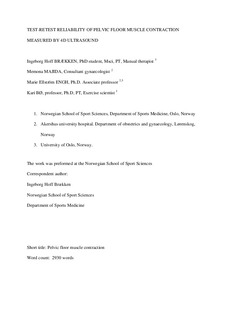| dc.contributor.author | Brækken, Ingeborg Hoff | |
| dc.contributor.author | Majida, Memona | |
| dc.contributor.author | Engh, Marie Ellstrøm | |
| dc.contributor.author | Bø, Kari | |
| dc.date.accessioned | 2009-02-23T09:42:14Z | |
| dc.date.issued | 2008-10-17 | |
| dc.identifier | Seksjon for idrettsmedisinske fag / Department of Sports Medicine | |
| dc.identifier.citation | Neurourology and Urodynamics. 2009, 28(1), 68-73 | en |
| dc.identifier.issn | 0733-2467 | |
| dc.identifier.uri | http://hdl.handle.net/11250/170413 | |
| dc.description | I Brage finner du pre-fagfellevurdert versjon av artikkelen, og den kan inneholde forskjeller fra forlagets pdf-versjon. Forlagets pdf-versjon finner du på http://dx.doi.org/10.1002/nau.20618 / In Brage you'll find the pre-peer reviewed version of the article, which has been published in final form at http://dx.doi.org/10.1002/nau.20618 | en |
| dc.description.abstract | Aims: The aim of the present study was to evaluate test-retest measurements of functional aspects of pelvic floor muscle (PFM) contraction using four dimensional (4D) ultrasound. Methods: Seventeen females preformed three maximal PFM contractions in standing, recorded by 4D real time ultrasound, on two separate occasions. Results: Very good and good reliability was fond for measurement of: Levator hiatus (LH) area, LH antero-posterior dimension, LH transverse dimension, puborectal muscle length and LH narrowing. Shortening of LH transverse distance and muscle length during contraction showed poor and fair reliability, respectively. In the mid sagittal plane the displacement of bladder neck, rectal ampulla and back sling of the poborectal muscle measured with on screen vector assessment demonstrated good reliability. During contraction the LH area was reduced 25% from resting area of 19.7 cm2 (95% CI = 16.8--22.7) to 14.70 cm2 (95% CI = 12.82--16.58). The muscle length shortened 21%, from 12.5 cm (95% CI = 11.1--13.8) to 9.70 cm (95% CI = 8.73--10.67). The mid urethra moved 1.1 mm (95% CI = 0.1--2.2) towards the pubic bone during contraction. The back sling of the puborectal muscle and the rectal ampulla had a greater displacement than the bladder neck (P > .004). The displacement of the pelvic organs was two times, or more, greater in the cranial versus anterior direction.
Conclusions: 4D ultrasound can reliable assess muscle length, narrowing of LH area, reduction of LH antero-posterior dimension and lift of BN, rectal ampulla and back sling of the puborectal muscle. Hence, both squeeze and lift can be quantified during PFM contraction. | en |
| dc.format.extent | 405204 bytes | |
| dc.format.mimetype | application/pdf | |
| dc.language.iso | eng | en |
| dc.publisher | Wiley InterScience | en |
| dc.subject | anatomy | en |
| dc.subject | bladder neck | en |
| dc.subject | cervix uteri | en |
| dc.subject | levator hiatus | en |
| dc.subject | muscle length | en |
| dc.subject | rectal ampulla | en |
| dc.subject | reproducibility | en |
| dc.title | Test-retest reliability of pelvic floor muscle contraction measured by 4D ultrasound | en |
| dc.type | Peer reviewed | en |
| dc.type | Journal article | en |
| dc.subject.nsi | VDP::Medical disciplines:700 | |
| dc.source.pagenumber | 68-73 | en |
| dc.source.volume | 28 | en |
| dc.source.journal | Neurourology and Urodynamics | en |
| dc.source.issue | 1 | en |
